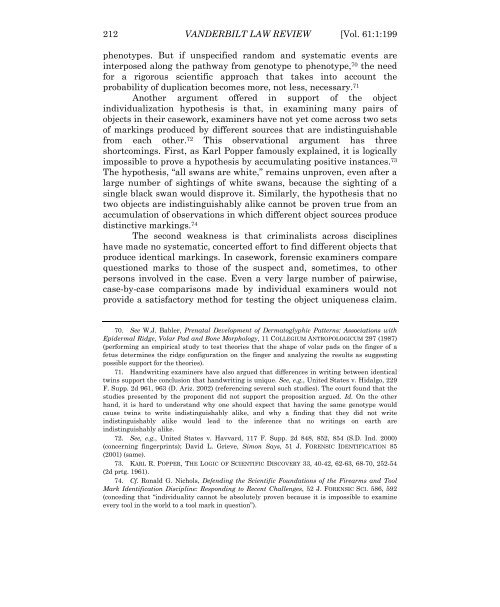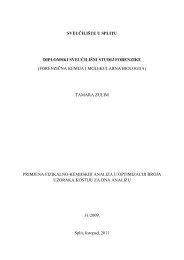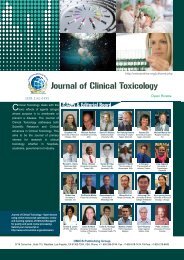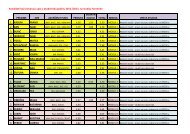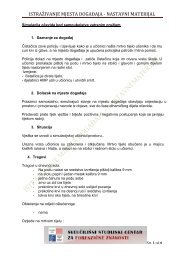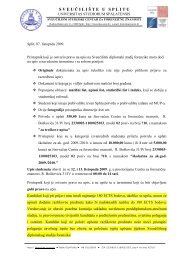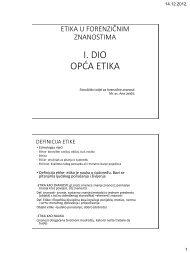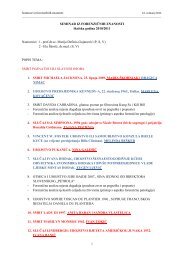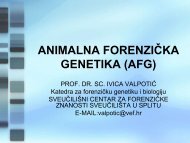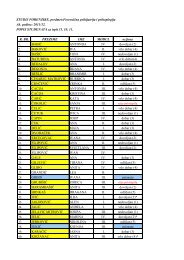The Individualization Fallacy in Forensic Science Evidence
The Individualization Fallacy in Forensic Science Evidence
The Individualization Fallacy in Forensic Science Evidence
You also want an ePaper? Increase the reach of your titles
YUMPU automatically turns print PDFs into web optimized ePapers that Google loves.
212 VANDERBILT LAW REVIEW [Vol. 61:1:199phenotypes. But if unspecified random and systematic events are<strong>in</strong>terposed along the pathway from genotype to phenotype, 70 the needfor a rigorous scientific approach that takes <strong>in</strong>to account theprobability of duplication becomes more, not less, necessary. 71Another argument offered <strong>in</strong> support of the object<strong>in</strong>dividualization hypothesis is that, <strong>in</strong> exam<strong>in</strong><strong>in</strong>g many pairs ofobjects <strong>in</strong> their casework, exam<strong>in</strong>ers have not yet come across two setsof mark<strong>in</strong>gs produced by different sources that are <strong>in</strong>dist<strong>in</strong>guishablefrom each other. 72 This observational argument has threeshortcom<strong>in</strong>gs. First, as Karl Popper famously expla<strong>in</strong>ed, it is logicallyimpossible to prove a hypothesis by accumulat<strong>in</strong>g positive <strong>in</strong>stances. 73<strong>The</strong> hypothesis, “all swans are white,” rema<strong>in</strong>s unproven, even after alarge number of sight<strong>in</strong>gs of white swans, because the sight<strong>in</strong>g of as<strong>in</strong>gle black swan would disprove it. Similarly, the hypothesis that notwo objects are <strong>in</strong>dist<strong>in</strong>guishably alike cannot be proven true from anaccumulation of observations <strong>in</strong> which different object sources producedist<strong>in</strong>ctive mark<strong>in</strong>gs. 74<strong>The</strong> second weakness is that crim<strong>in</strong>alists across discipl<strong>in</strong>eshave made no systematic, concerted effort to f<strong>in</strong>d different objects thatproduce identical mark<strong>in</strong>gs. In casework, forensic exam<strong>in</strong>ers comparequestioned marks to those of the suspect and, sometimes, to otherpersons <strong>in</strong>volved <strong>in</strong> the case. Even a very large number of pairwise,case-by-case comparisons made by <strong>in</strong>dividual exam<strong>in</strong>ers would notprovide a satisfactory method for test<strong>in</strong>g the object uniqueness claim.70. See W.J. Babler, Prenatal Development of Dermatoglyphic Patterns: Associations withEpidermal Ridge, Volar Pad and Bone Morphology, 11 COLLEGIUM ANTROPOLOGICUM 297 (1987)(perform<strong>in</strong>g an empirical study to test theories that the shape of volar pads on the f<strong>in</strong>ger of afetus determ<strong>in</strong>es the ridge configuration on the f<strong>in</strong>ger and analyz<strong>in</strong>g the results as suggest<strong>in</strong>gpossible support for the theories).71. Handwrit<strong>in</strong>g exam<strong>in</strong>ers have also argued that differences <strong>in</strong> writ<strong>in</strong>g between identicaltw<strong>in</strong>s support the conclusion that handwrit<strong>in</strong>g is unique. See, e.g., United States v. Hidalgo, 229F. Supp. 2d 961, 963 (D. Ariz. 2002) (referenc<strong>in</strong>g several such studies). <strong>The</strong> court found that thestudies presented by the proponent did not support the proposition argued. Id. On the otherhand, it is hard to understand why one should expect that hav<strong>in</strong>g the same genotype wouldcause tw<strong>in</strong>s to write <strong>in</strong>dist<strong>in</strong>guishably alike, and why a f<strong>in</strong>d<strong>in</strong>g that they did not write<strong>in</strong>dist<strong>in</strong>guishably alike would lead to the <strong>in</strong>ference that no writ<strong>in</strong>gs on earth are<strong>in</strong>dist<strong>in</strong>guishably alike.72. See, e.g., United States v. Havvard, 117 F. Supp. 2d 848, 852, 854 (S.D. Ind. 2000)(concern<strong>in</strong>g f<strong>in</strong>gerpr<strong>in</strong>ts); David L. Grieve, Simon Says, 51 J. FORENSIC IDENTIFICATION 85(2001) (same).73. KARL R. POPPER, THE LOGIC OF SCIENTIFIC DISCOVERY 33, 40-42, 62-63, 68-70, 252-54(2d prtg. 1961).74. Cf. Ronald G. Nichols, Defend<strong>in</strong>g the Scientific Foundations of the Firearms and ToolMark Identification Discipl<strong>in</strong>e: Respond<strong>in</strong>g to Recent Challenges, 52 J. FORENSIC SCI. 586, 592(conced<strong>in</strong>g that “<strong>in</strong>dividuality cannot be absolutely proven because it is impossible to exam<strong>in</strong>eevery tool <strong>in</strong> the world to a tool mark <strong>in</strong> question”).


